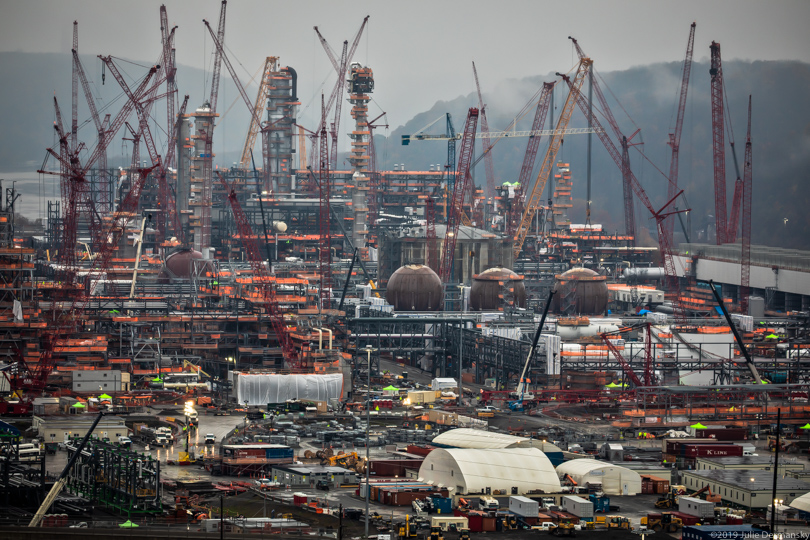While the Ohio River Valley, long home to the coal and steel industries, is no stranger to air pollution, the region’s natural gas boom and burgeoning petrochemical industry threaten to erase the gains of recent decades. Concerns about air quality, which has already begun declining nationally since 2016, are growing rapidly for those living in the shadow of Shell’s $6 billion plastics plant under construction along the Ohio River in western Pennsylvania’s Beaver County.
Residents and activists from the greater Pittsburgh area fear that worsening air quality will lower the value of homes, deter new clean business development, and sicken people.
“It is not lost on us that Allegheny Health Network is building a cancer institute directly above the cracker plant at the Beaver County Mall,” Matt Mehalik, executive director of the advocacy group Breathe Project, said at a November 6 public meeting about the Shell plastics plant, also known as an “ethane cracker.” “There is a certain degree of sick irony about that.”
He warned of the significant healthcare impacts, and the associated financial cost to treat them, from the development of the petrochemical industry in the region.
Matt Mehalik, executive director of the advocacy group Breathe Project, speaking at the Beaver Library.
Booming Industry, Booming Local Concerns
The public meeting, which took place in the town of Beaver, thirty miles northwest of Pittsburgh, was standing room only. Those attending were seeking information about how the expanding natural gas industry, and the infrastructure and petrochemical plants that are coming with it, will have on the region and what they can do to stop it from happening.
According to the U.S. Office of Fossil Energy, Appalachian shale gas, primarily from the Marcellus and Utica shale plays, is the main driver for growth of the U.S. natural gas industry.
“The Appalachian region has abundant resources and extensive downstream industrial activity, particularly in the quad-state area of West Virginia, Pennsylvania, Ohio, and Kentucky,” a post on the Office of Fossil Energy website says, adding that petrochemical infrastructure represents a key opportunity for the region.
The agency touts the potential jobs and business and tax revenues the petrochemical industry could bring to the region. Missing is any mention that with the natural gas and petrochemical industries’ expansion comes a rise in emissions of greenhouse gases, volatile organic compounds, and particulate matter, along with related environmental and health impacts.
Mehalik listed to me the reasons for the growing number of people pushing back against the fossil fuel industry in the Ohio River Valley, despite its traditionally industry-friendly attitudes.
“The region is experiencing increasing levels of trauma in the form of environmental disasters that are catching people’s attention,” he said. “The explosion of pipelines, drilling mud spills, wells that are vented, frack water truck traffic everywhere, permitting fights in local municipal governments regionally over petrochemical infrastructure projects, stories of farmland and people’s homes being ruined, water supplies being ruined, and an increasing sense of doom as the Shell plant’s future reality takes shape on the banks of the Ohio [River] across from neighborhoods.”
Another reason Mehalik identified in Pennsylvania was “frustration as the state goes out of its way to avoid explaining the very high number of rare cancers appearing in communities with the densest frack well concentration in the state.”
Rooms With a View
The day after the November 6 public meeting in Beaver, I stopped by the site of the new cancer institute. The construction looked complete from the outside though the center has yet to open. From its grounds, construction of Shell’s plastics plant, which at its peak is expected to produce 3.5 billion pounds of polyethylene pellets a year, is clearly visible. Near the cancer institute, a subdivision is also under construction, where new homes will also offer an even better view of the sprawling petrochemical complex.
Newly built Allegheny Health Network Cancer Institute in Monaca, Pennsylvania, next to a home in a subdivision that overlooks Shell’s plastics plant.
View of Shell’s new petrochemical complex at the end of a road in a Beaver, Pennsylvania, housing subdivision currently under construction.
The construction of a new housing development overlooking Shell’s plant suggests not everyone is worried about the health impacts of living close to industrial sites like this one. The fossil fuel industry maintains a strong influence with Pennsylvania’s top legislators, including its Democratic Gov. Tom Wolf.
Residents in nearby Washington County, also in southwestern Pennsylvania, elevated to Gov. Wolf their concerns that his administration is not doing more to investigate the possibility that natural gas industry activity is tied to the area’s spike in an extremely rare childhood cancer during a meeting in the state capitol on November 18.
According to the Associated Press, “dozens of children and young adults have been diagnosed with Ewing sarcoma and other forms of cancer in a four-county region of southwestern Pennsylvania where energy companies have drilled more than 3,500 wells since 2008,” and “an investigation by the Pittsburgh Post-Gazette this year identified six Ewing cases in a single school district.”
The meeting led to Gov. Wolf’s recent announcement of over $3 million set aside for research into potential links between natural gas industry activity and health impacts including Ewing sarcoma.
A Community Already Grappling With Industrial Pollution
Residents in Clairton, just south of Pittsburgh, are also questioning how the growing petrochemical industry might add to existing health impacts they are dealing with from existing industrial pollution.
Emissions rising from U.S. Steel’s Clairton Plant, in Clairton, Pennsylvania.
A PennEnvironment Research & Policy Center report found that U.S. Steel’s Clairton Plant, which manufactures coke, the coal product used in the steel-making process, is one of the top air polluters in its county. And the Environmental Protection Agency’s most recent National Air Toxics Assessment, which evaluates air contaminants and estimates health risks, identified an elevated cancer risk from toxic air pollution in Clairton.
Piles of coke at U.S. Steel’s Clairton Plant in Clairton.
Johnie Perryman wearing a respirator in his living room in Clairton.
Emissions from the Clairton Plant behind a church near Johnie Perryman’s house in Clairton.
Johnie Perryman, who retired and moved to Clairton 12 years ago, told me he has no doubt that the polluted air from local industry has diminished his health, which he noticed worsening shortly after he arrived. He has a heart condition and finds breathing difficult. He keeps a respirator nearby and wears it even inside his house on bad air days, which he said are most days. He told me he considered moving but at this point doesn’t have the resources or the energy.
Melanie Meade, an environmental activist and homeowner in Clairton.
Melanie Meade, a certified natural health professional who also lives in Clairton, echoed similar worries about the health impacts of local air pollution. She too considered moving once she learned how toxic the air can be, but she doesn’t want to give up her family’s home, which has been in the family for three generations.
Meade met Perryman at a community meeting about clean air a couple years ago. I met them at Perryman’s house on what they both described as a bad air day. Emissions from the plant could be seen from the hill where Perryman’s house sits. Meade stops in and checks on him, as she does with many of the elders in the community.
Meade says she became an environmental activist to protect herself and her community from existing polluters as well as the slew of new petrochemical plants on the horizon, including Shell’s new plastics plant. She sees parallels between the situations in southwestern Pennsylvania and Louisiana’s Cancer Alley, an 80-mile stretch along the banks of the Mississippi River that is already thick with air pollution and industrial sites fed by fossil fuels and which is also threatened by the expanding petrochemical industry.
Petrochemical Expansions in Louisiana and Pennsylvania
Louisiana, another shale-rich state, is attracting even more petrochemical companies, along with infrastructure projects to support the natural gas industry. Formosa’s proposed $9.4 billion petrochemical complex in St. James could double the amount of toxic emissions in an area already heavily affected by pollution.
Louisiana’s governor, John Bel Edwards, like Pennsylvania’s Gov. Wolf, has welcomed the petrochemical industry expansion. But he too is facing resistance from residents concerned about the health impacts from industrial sites fueled by oil and gas.
The Denka synthetic rubber plant in St. John the Baptist Parish, Louisiana.
In 2016, the community in St. John the Baptist Parish near Denka’s synthetic rubber plant, about 25 miles from Formosa’s planned petrochemical complex, became aware of the EPA’s National Air Toxics Assessment. The assessment had found that those living near Denka’s plant have the nation’s highest risk of cancer from air pollution.
Like Washington County residents in Pennsylvania, residents in St. John the Baptist Parish asked the state to do a health study. And like in Pennsylvania, the State of Louisiana has downplayed the community’s concerns until this past August announcing plans to research cancer rates in the area.
In both states, pushback against the intertwined natural gas and petrochemical industries is being framed by some as a conflict between jobs and the environment. But environmental advocates call this a false narrative, pointing to the job potential of the renewable and energy efficiency sectors, which are growing in the United States and around the world, according to the sustainability nonprofit Environmental and Energy Study Institute.
Mehalik is hopeful that the industries’ framing won’t prevail. “People were pulling together to clean up and rebuild the region around the idea of a clean environment and healthy jobs” for the last decade, he told me. “There are many of us who will not give up on the progress that we have been making and can continue to make despite the intrusion of petrochemicals on the landscape.”
Main image: Shell’s plastics plant, also known as an “ethane cracker,” under construction in Beaver County, Pennsylvania. Credit: All photos and video by Julie Dermansky for DeSmog
Subscribe to our newsletter
Stay up to date with DeSmog news and alerts















